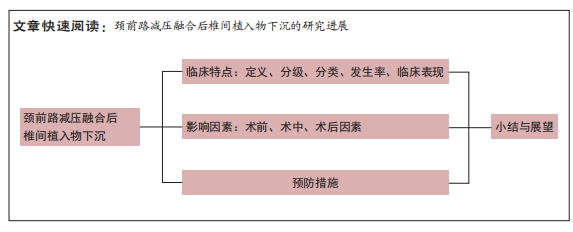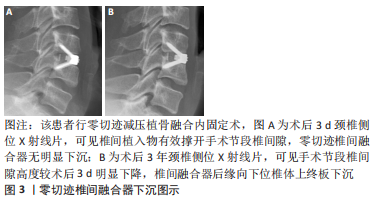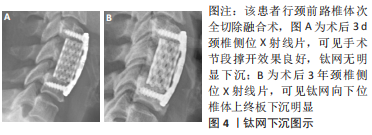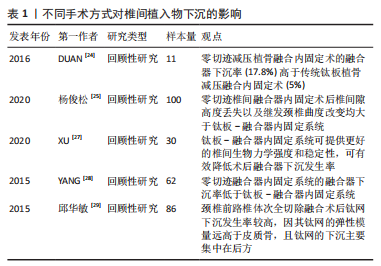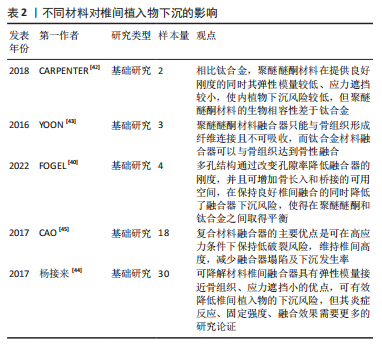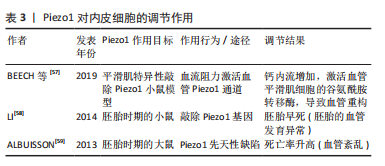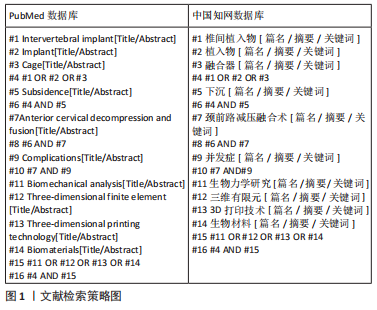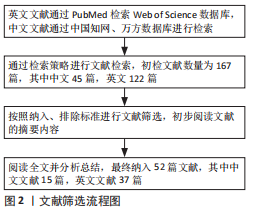[1] ZHANG AS, MYERS C, MCDONALD CL, et al. Cervical Myelopathy: Diagnosis, Contemporary Treatment, and Outcomes. Am J Med. 2022; 135(4):435-443.
[2] NOORDHOEK I, KONING MT, JACOBS WCH, et al. Incidence and clinical relevance of cage subsidence in anterior cervical discectomy and fusion: a systematic review. Acta Neurochir (Wien). 2018;160(4):873-880.
[3] CORNIOLA MV, JAGERSEERG M, STIENEN MN, et al. Complete cage migration/subsidence into the adjacent vertebral body after posterior lumbar interbody fusion. J Clin Neurosci. 2015;22(3):597-598.
[4] PINTER ZW, REED R, TOWNSLEY SE, et al. Titanium Cervical Cage Subsidence: Postoperative Computed Tomography Analysis Defining Incidence and Associated Risk Factors. Global Spine J. 2021: 21925682211046897.
[5] FUJIBAYASHI S, NEO M, NAKAMURA T. Stand-alone interbody cage versus anterior cervical plate for treatment of cervical disc herniation: sequential changes in cage subsidence. J Clin Neurosci. 2008;15(9):1017-1022.
[6] NAKANISHI Y, NAITO K, YAMAGATA T, et al. Safety of anterior cervical discectomy and fusion using titanium-coated polyetheretherketone stand-alone cages: Multicenter prospective study of incidence of cage subsidence. J Clin Neurosci. 2020;74:47-54.
[7] CHEN Y, LV G, WANG B, et al. A comparison of anterior cervical discectomy and fusion (ACDF) using self-locking stand-alone polyetheretherketone (PEEK) cage with ACDF using cage and plate in the treatment of three-level cervical degenerative spondylopathy: a retrospective study with 2-year follow-up. Eur Spine J. 2016;25(7): 2255-2262.
[8] 唐福波,周劲衍,张翼升,等.颈椎前路单椎体次全切钛笼植骨融合后钛笼下沉的相关危险因素[J].中国组织工程研究,2019,23(12): 1818-1823.
[9] KARIKARI IO, JAIN D, OWENS TR, et al. Impact of subsidence on clinical outcomes and radiographic fusion rates in anterior cervical discectomy and fusion: a systematic review. J Spinal Disord Tech. 2014;27(1):1-10.
[10] ALIMI M, LANG G, NAVARRO-RAMIREZ R, et al. The Impact of Cage Dimensions, Positioning, and Side of Approach in Extreme Lateral Interbody Fusion. Clin Spine Surg. 2018;31(1):E42-E49.
[11] WU WJ, JIANG LS, LIANG Y, et al. Cage subsidence does not, but cervical lordosis improvement does affect the long-term results of anterior cervical fusion with stand-alone cage for degenerative cervical disc disease: a retrospective study. Eur Spine J. 2012;21(7):1374-1382.
[12] ZHANG JD, POFFYN B, SYS G, et al. Are stand-alone cages sufficient for anterior lumbar interbody fusion. Orthop Surg. 2012;4(1):11-14.
[13] MACCORMICK AP, SHARMA H. Analysis of the Variables Affecting the Incidence, Location, and Severity of Cage Subsidence Following Anterior Cervical Discectomy and Fusion Operation. Int J Spine Surg. 2020;14(6):896-900.
[14] LEE CH, KIM KJ, HYUN SJ, et al. Subsidence as of 12 months after single-level anterior cervical inter-body fusion. Is it related to clinical outcomes. Acta Neurochir. 2015;157(6):1063-1068.
[15] 韩俊,黄勇.颈椎ACCF术后出现钛笼下沉的危险因素Logistic回归分析[J].颈腰痛杂志,2019,40(4):442-444.
[16] 邱华敏.颈椎前路椎体次全切除减压融合术后钛笼下沉的影响因素分析[D].南宁:广西医科大学,2015.
[17] JI C, YU S, YAN N, et al. Risk factors for subsidence of titanium mesh cage following single-level anterior cervical corpectomy and fusion. BMC Musculoskelet Disord. 2020;21(1):32.
[18] JIN ZY, TENG Y, WANG HZ, et al. Comparative Analysis of Cage Subsidence in Anterior Cervical Decompression and Fusion: Zero Profile Anchored Spacer (ROI-C) vs. Conventional Cage and Plate Construct. Front Surg. 2021;8:736680.
[19] YAMAGATA T, TAKAMI T, UDA T, et al. Outcomes of contemporary use of rectangular titanium stand-alone cages in anterior cervical discectomy and fusion: cage subsidence and cervical alignment. J Clin Neurosci. 2012;19(12):1673-1678.
[20] 蔡忠香,马永刚.颈椎前路融合术后12例钛笼下沉临床分析[J].生物骨科材料与临床研究,2011,8(1):52-53.
[21] VAN JONBERGEN HP, SPRUIT M, ANDERSON PG, et al. Anterior cervical interbody fusion with a titanium box cage: early radiological assessment of fusion and subsidence. Spine J. 2005;5(6):645-649.
[22] KAO TH, WU CH, CHOU YC, et al. Risk factors for subsidence in anterior cervical fusion with stand-alone polyetheretherketone (PEEK) cages: a review of 82 cases and 182 levels. Arch Orthop Trauma Surg. 2014; 134(10):1343-1351.
[23] LU Y, FANG Y, SHEN X, et al. Does zero-profile anchored cage accompanied by a higher postoperative subsidence compared with cage-plate construct? A meta-analysis. J Orthop Surg Res. 2020;15(1): 189.
[24] DUAN Y, YANG Y, WANG Y, et al. Comparison of anterior cervical discectomy and fusion with the zero-profile device versus plate and cage in treating cervical degenerative disc disease: A meta-analysis. J Clin Neurosci. 2016;33:11-18.
[25] 杨俊松,刘鹏,刘团江,等.零切迹椎间融合器与钛板-椎间融合器系统对颈前路术后颈椎曲度维持的临床研究[J].中国修复重建外科杂志,2020,34(2):151-156.
[26] 姚晓玲,彭建城,许岳荣,等.可变角度零切迹前路椎间融合内固定系统治疗脊髓型颈椎病:30个月随访[J].中国组织工程研究, 2022,26(9):1377-1382.
[27] XU J, HE Y, LI Y, et al. Incidence of Subsidence of Seven Intervertebral Devices in Anterior Cervical Discectomy and Fusion: A Network Meta-Analysis. World Neurosurg. 2020;141:479-489.
[28] YANG H, CHEN D, WANG X, et al. Zero-profile integrated plate and spacer device reduces rate of adjacent-level ossification development and dysphagia compared to ACDF with plating and cage system. Arch Orthop Trauma Surg. 2015;135(6):781-787.
[29] 邱华敏,詹新立.双节段颈椎前路椎体次全切除融合术后钛笼下沉的影响因素分析[J].骨科,2015,6(3):130-134.
[30] 杨毅,刘浩,孟阳.颈椎融合器的研究历史与现状[J].生物骨科材料与临床研究,2020,17(3):62-65.
[31] 程招军,彭兵,范俊超,等.脊髓型颈椎病患者颈椎 MRI与X线片矢状位参数的对比分析[J].中国脊柱脊髓杂志,2016,26(7):591-595.
[32] YANG JJ, YU CH, CHANG BS, et al. Subsidence and nonunion after anterior cervical interbody fusion using a stand-alone polyetheretherketone (PEEK) cage. Clin Orthop Surg. 2011;3(1): 16-23.
[33] 马永刚,刘世清,李亚明,等.颈椎前路减压融合术后钛笼下沉临床分析[J].中国脊柱脊髓杂志,2011,21(1):21-23.
[34] CHOI WS, KIM JS, HUR JW, et al. Minimally Invasive Transforaminal Lumbar Interbody Fusion Using Banana-Shaped and Straight Cages: Radiological and Clinical Results from a Prospective Randomized Clinical Trial. Neurosurgery. 2018;82(3):289-298.
[35] WILKE HJ, KETTLER A, GOETZ C, et al. Subsidence resulting from simulated postoperative neck movements: an in vitro investigation with a new cervical fusion cage. Spine (Phila Pa 1976). 2000;25(21): 2762-2770.
[36] 王甲甲.人体颈椎有限元建模及仿生颈椎椎间融合器研究[D].长春:吉林大学,2014.
[37] WANG Y, LU T, HE X, et al. Effect of Dome-Shaped Titanium Mesh Cages on Cervical Endplate Under Cyclic Loading: An In Vitro Biomechanics Study. Med Sci Monit. 2019;25:142-149.
[38] ZHANG H, JIANG Y, WANG B, et al. Direction-changeable lumbar cage versus traditional lumbar cage for treating lumbar spondylolisthesis: A retrospective study. Medicine (Baltimore). 2018;97(7):e9984.
[39] 舒启航,廖亦佳,薛静波,等.新型颈椎3D打印多孔椎间融合器的三维有限元分析[J].中国组织工程研究,2021,25(24):3810-3815.
[40] FOGEL G, MARTIN N, LYNCH K, et al. Subsidence and fusion performance of a 3D-printed porous interbody cage with stress-optimized body lattice and microporous endplates - a comprehensive mechanical and biological analysis. Spine J. 2022;22(6):1028-1037.
[41] 王林楠,杨曦,宋跃明. 3D打印技术在椎间融合临床应用的研究进展[J].华西医学,2018,33(9):1061-1067.
[42] CARPENTER RD, KLOSTERHOFF BS, TORSTRICK FB, et al. Effect of porous orthopaedic implant material and structure on load sharing with simulated bone ingrowth: A finite element analysis comparing titanium and PEEK. J Mech Behav Biomed Mater. 2018;80:68-76.
[43] YOON BJ, XAVIER F, WALKER BR, et al. Optimizing surface characteristics for cell adhesion and proliferation on titanium plasma spray coatings on polyetheretherketone. Spine J. 2016;16(10):1238-1243.
[44] 杨接来,徐俊,谷辉杰,等. 3D打印聚乳酸/纳米级 -磷酸钙可吸收山羊颈椎融合器的生物相容性及生物力学评价[J].中国临床医学,2017,24(4):525-530.
[45] CAO L, CHEN Q, JIANG LB, et al. Bioabsorbable self-retaining PLA/nano-sized beta-TCP cervical spine interbody fusion cage in goat models: an in vivo study. Int J Nanomedicine. 2017;12:7197-7205.
[46] BRENKE C, KINDLING S, SCHARF J, et al. Short-term experience with a new absorbable composite cage (β-tricalcium phosphate-polylactic acid) in patients after stand-alone anterior cervical discectomy and fusion. Spine (Phila Pa 1976). 2013;38(11):E635-E640.
[47] YANG X, SONG Y, LIU L, et al. Mid-term effectiveness of anterior decompression and fusion with nano-hydroxyapatite/polyamide 66 cage in treatment of cervical spondylotic myelopathy. Zhongguo Xiu Fu Chong Jian Wai Ke Za Zhi. 2013;27(9):1085-1089.
[48] LI S, ZHANG H, SHEN Y, et al. Risk factors of cage subsidence after removal of localized heterotopic ossification by anterior cervical discectomy and fusion: A retrospective multivariable analysis. Medicine (Baltimore). 2019;98(42):e17505.
[49] KIM MC, CHUNG HT, CHO JL, et al. Subsidence of polyetheretherketone cage after minimally invasive transforaminal lumbar interbody fusion. J Spinal Disord Tech. 2013;26(2):87-92.
[50] CHOI MK, KIM SB, LEE JH. Rare Intractable Cervicalgia Related to Exaggerated Disc Height Distraction : Report of Two Cases and Literature Review. J Korean Neurosurg Soc. 2018;61(4):530-536.
[51] WANG S, ZHU J, SUN K, et al. Clinical impact and imaging results after a modified procedure of ACDF: a prospective case-controlled study based on ninety cases with two-year follow-up. BMC Musculoskelet Disord. 2021;22(1):605.
[52] 宋萌,朱灏宇,朱庆三,等.单节段颈椎椎体次全切除钛笼植骨融合术后钛笼下沉相关危险因素分析[J].中国脊柱脊髓杂志,2017, 27(8):681-685. |
